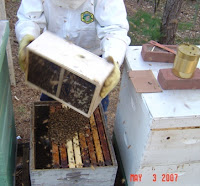
Paul and Clare picked up 106 packages of bees for our club last week. Thanks Paul and Clare.
There is no guarantee that the established hives will work any specific crop, but the hive just brought to a location will work the nearest crop it can find.

My friend Gene taking his bees to their new home. He got stung earlier that afternoon.
Our packages of bees finally arrived this week. Their delivery had been delayed due to all the poor weather down south this spring. I even heard a story about a bee breeder who lost 100 hives to a tornado….
A queen cage placed in a homemade hanger
.
The installation of a package of bees can be intimidating if you have never done it before. The installation (or housing) of a package of bees consists of removing the thin wood cover, from the package, to exposed the queen cage and the can of sugar water.
Prior to removing the queen cage the package of 4,000 bees is slammed on the ground to dislodge the bees from the top of the package so the queen cage and the can of feed can be removed.
As it’s name implies the queen cage contains the queen bee. At this point she can be inspected to make sure she is alive and healthy.
There is candy in one end of the cage which separates the queen from the opening in the cage. The queen cage is suspended between the frames of comb with the opening facing upward.
The plan is that once the bees eat through the candy the queen is released in the hive. This is a kind of time-delay so to speak.
It will take about three to four days for the queen to be freed from the cage. By this time the bees have accepted this new place as their home, and stay.
Shaking a package of bees into the hive
Once the queen is suspended in the hive the bees are shaken out of the package onto the queen and into the hive. Of course most of the bees fall into the box, but many fly around. At times the air can bee filled with buzzing bees. Although intimidating, this is the time where the bees are most docile. The bees have no home to protect, so they are not aggressive. Once the top feeder and the cover are installed, some bees will find the entrance to the hive, expose their sent glands and start fanning. This is the signal which allows all the flying bees to find their new home.
But watch out. In about a half an hour the bees start to become protective of their new home. My friend Gene gets stung every year at this point in the installation.
Once the queen is suspended in the hive the bees are shaken out of the package onto the queen and into the hive. Of course most of the bees fall into the box, but many fly around. At times the air can bee filled with buzzing bees. Although intimidating, this is the time where the bees are most docile. The bees have no home to protect, so they are not aggressive. Once the top feeder and the cover are installed, some bees will find the entrance to the hive, expose their sent glands and start fanning. This is the signal which allows all the flying bees to find their new home.
But watch out. In about a half an hour the bees start to become protective of their new home. My friend Gene gets stung every year at this point in the installation.
He gets stung. But I don’t.

It was interesting to note that last week none of the five hives were working the fruit trees. But within hours of the installation, the new bees were working them. This is why crop pollination is so important.

It was interesting to note that last week none of the five hives were working the fruit trees. But within hours of the installation, the new bees were working them. This is why crop pollination is so important.
There is no guarantee that the established hives will work any specific crop, but the hive just brought to a location will work the nearest crop it can find.

My friend Gene taking his bees to their new home. He got stung earlier that afternoon.
It's become a yearly tradition.











No comments:
Post a Comment